maintenance schedule Acura RL 2000 3.5 Owner's Guide
[x] Cancel search | Manufacturer: ACURA, Model Year: 2000, Model line: RL, Model: Acura RL 2000Pages: 330, PDF Size: 4.53 MB
Page 234 of 330
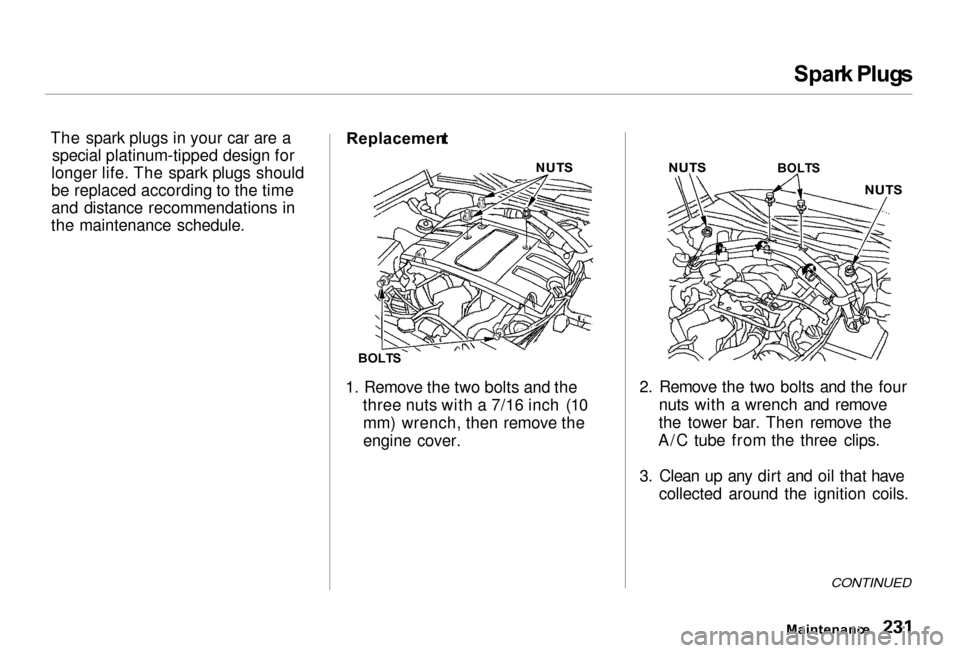
Spar
k Plug s
The spark plugs in your car are a special platinum-tipped design for
longer life. The spark plugs should
be replaced according to the time
and distance recommendations in
the maintenance schedule. Replacemen
t
1. Remove the two bolts and the three nuts with a 7/16 inch (10mm) wrench, then remove the
engine cover. 2. Remove the two bolts and the four
nuts with a wrench and remove
the tower bar. Then remove the
A/C tube from the three clips.
3. Clean up any dirt and oil that have collected around the ignition coils.
CONTINUED
Maintenanc e
NUT
S
BOLT S
NUT
S
BOLTS
NUTS
Page 244 of 330
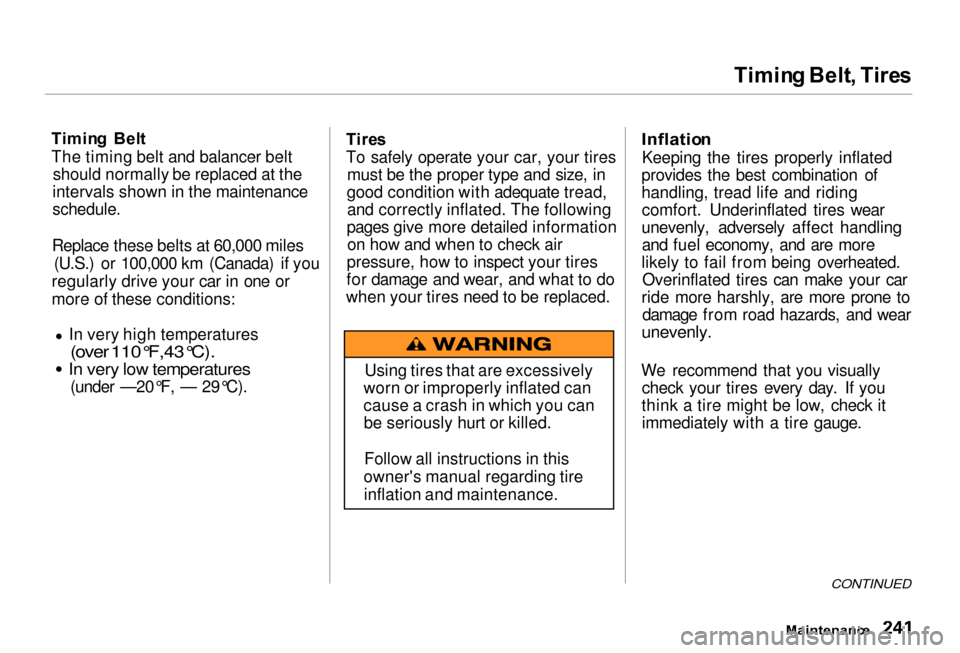
Timin
g Belt , Tire s
Timin g Bel t
The timing belt and balancer belt should normally be replaced at the
intervals shown in the maintenance
schedule.
Replace these belts at 60,000 miles (U.S.) or 100,000 km (Canada) if you
regularly drive your car in one or
more of these conditions:
In very high temperatures
(over 110°F,43°C).
In very low temperatures
(under —20°F, — 29°C). Tire
s
To safely operate your car, your tires must be the proper type and size, in
good condition with adequate tread, and correctly inflated. The following
pages give more detailed information on how and when to check air
pressure, how to inspect your tires
for damage and wear, and what to do
when your tires need to be replaced.
Inflatio
n
Keeping the tires properly inflated
provides the best combination of
handling, tread life and riding comfort. Underinflated tires wear
unevenly, adversely affect handling and fuel economy, and are more
likely to fail from being overheated. Overinflated tires can make your car
ride more harshly, are more prone to damage from road hazards, and wear
unevenly.
We recommend that you visually check your tires every day. If you
think a tire might be low, check it immediately with a tire gauge.
CONTINUED
Maintenanc e
Using tires that are excessively
worn or improperly inflated can
cause a crash in which you can be seriously hurt or killed.
Follow all instructions in this
owner's manual regarding tire inflation and maintenance.
Page 262 of 330
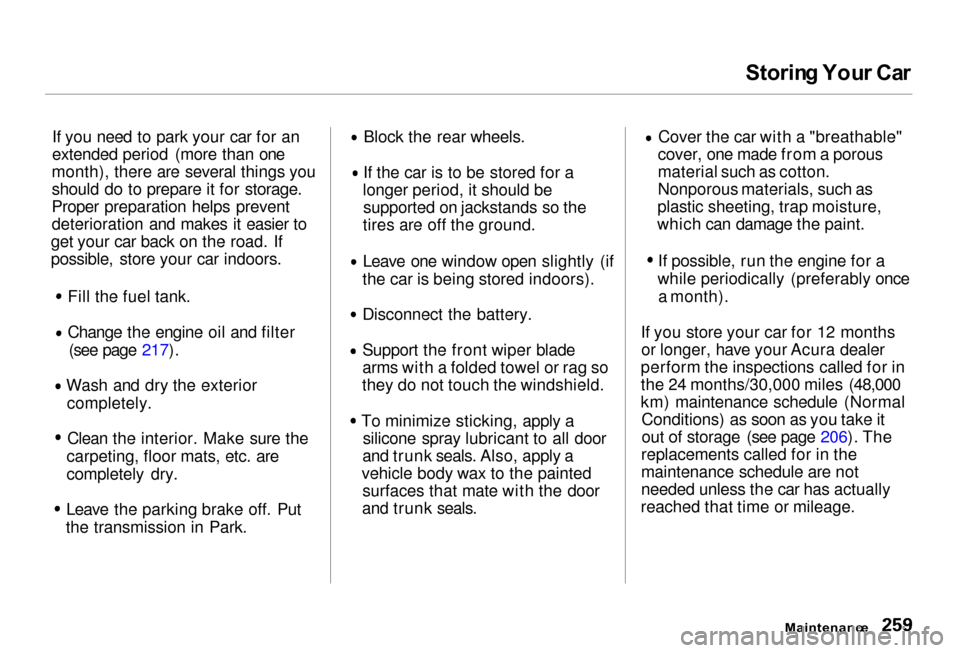
Storin
g You r Ca r
If you need to park your car for an
extended period (more than one
month), there are several things you
should do to prepare it for storage.
Proper preparation helps prevent
deterioration and makes it easier to
get your car back on the road. If
possible, store your car indoors. Fill the fuel tank.
Change the engine oil and filter
(see page 217). Wash and dry the exterior
completely.
Clean the interior. Make sure the
carpeting, floor mats, etc. are
completely dry. Leave the parking brake off. Put
the transmission in Park. Block the rear wheels.
If the car is to be stored for a
longer period, it should be supported on jackstands so the
tires are off the ground. Leave one window open slightly (if
the car is being stored indoors). Disconnect the battery.
Support the front wiper blade
arms with a folded towel or rag so
they do not touch the windshield.
To minimize sticking, apply a silicone spray lubricant to all door
and trunk seals. Also, apply a
vehicle body wax to the painted surfaces that mate with the door
and trunk seals. Cover the car with a "breathable"
cover, one made from a porous
material such as cotton.
Nonporous materials, such as
plastic sheeting, trap moisture,
which can damage the paint. If possible, run the engine for a
while periodically (preferably once a month).
If you store your car for 12 months or longer, have your Acura dealer
perform the inspections called for in
the 24 months/30,000 miles (48,000
km) maintenance schedule (Normal Conditions) as soon as you take it
out of storage (see page 206). The
replacements called for in the
maintenance schedule are not
needed unless the car has actually
reached that time or mileage.
Maintenance
Page 308 of 330

Emission
s Control s
The burning of gasoline in your car's engine produces several byproducts.
Some of these are carbon monoxide (CO), oxides of nitrogen (NOx) and
hydrocarbons (HC). Gasoline evaporating from the tank also
produces hydrocarbons. Controlling
the production of NOx, CO, and HC
is important to the environment.
Under certain conditions of sunlight
and climate, NOx and HC react to
form photochemical "smog." Carbon
monoxide does not contribute to smog creation, but it is a poisonous
gas.
Th
e Clea n Ai r Ac t
The United States Clean Air Act*
sets standards for automobile
emissions. It also requires that
automobile manufacturers explain to owners how their emissions controls
work and what to do to maintain
them. This section summarizes how
the emissions controls work.
Scheduled maintenance is on page
206.
* In Canada, Acura vehicles comply
with the Canadian Motor Vehicle
Safety Standards (CMVSS) for
Emissions valid at the time they are
manufactured.
Crankcas e Emission s Contro l
Syste m
Your car has a Positive Crankcase
Ventilation System. This keeps gasses that build up in the engine'scrankcase from going into the
atmosphere. The Positive Crankcase
Ventilation valve routes them from the crankcase back to the intake
manifold. They are then drawn into
the engine and burned.
Evaporativ e Emission s Contro l
Syste m
As gasoline evaporates in the fuel tank, an evaporative emissionscontrol canister filled with charcoal
adsorbs the vapor. It is stored in this
canister while the engine is off. After
the engine is started and warmed up,
the vapor is drawn into the engine and burned during driving.
Onboar d Refuelin g Vapo r
Recover y
The Onboard Refueling Vapor Recovery (ORVR) system captures
the fuel vapors during refueling. The
vapors are adsorbed in a canister
filled with activated carbon. While driving, the fuel vapors are drawn
into the engine and burned off.
Technical Informatio n
Page 325 of 330
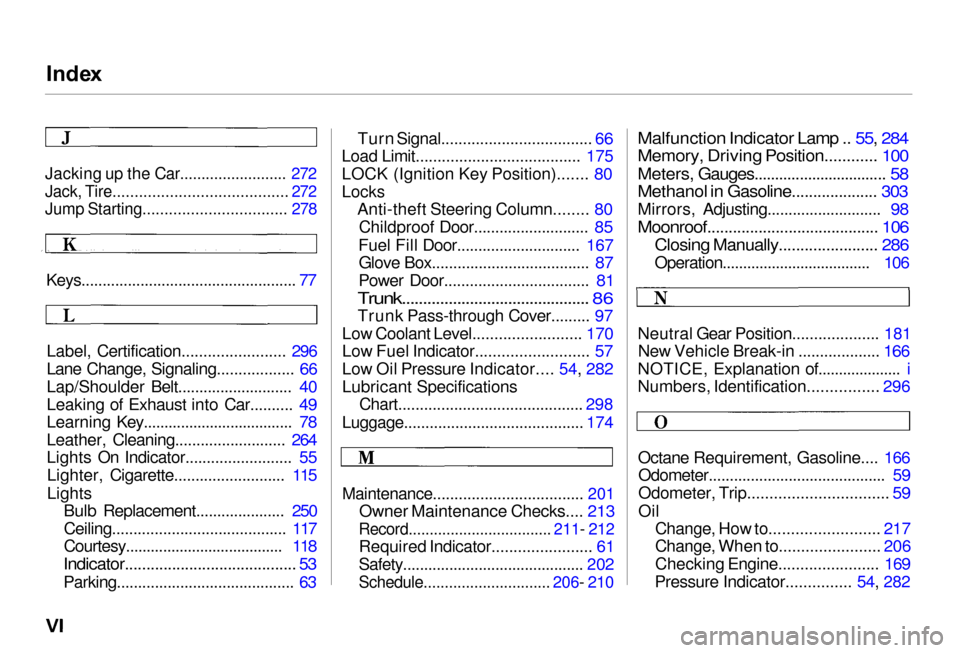
Inde
x
Jacking up the Car......................... 272
Jack, Tire........................................ 272
Jump Starting................................. 278
Keys................................................... 77
Label, Certification........................ 296
Lane Change, Signaling.................. 66
Lap/Shoulder Belt........................... 40
Leaking of Exhaust into Car.......... 49
Learning Key.................................... 78
Leather, Cleaning.......................... 264
Lights On Indicator......................... 55Lighter, Cigarette.......................... 115
Lights Bulb Replacement..................... 250
Ceiling......................................... 117
Courtesy...................................... 118
Indicator........................................ 53
Parking.......................................... 63 Turn Signal................................... 66Load Limit...................................... 175
LOCK (Ignition Key Position)....... 80
Locks
Anti-theft Steering Column........ 80
Childproof Door........................... 85
Fuel Fill Door............................. 167
Glove Box.....................................
87
Power Door.................................. 81
Trunk............................................ 86
Trunk Pass-through Cover......... 97
Low Coolant Level......................... 170
Low Fuel Indicator.......................... 57
Low Oil Pressure Indicator.... 54, 282
Lubricant Specifications
Chart........................................... 298
Luggage.......................................... 174
Maintenance................................... 201
Owner Maintenance Checks.... 213
Record.................................. 211- 212
Required Indicator....................... 61
Safety........................................... 202
Schedule.............................. 206- 210
Malfunction Indicator Lamp .. 55, 284
Memory, Driving Position............ 100
Meters, Gauges................................ 58
Methanol in Gasoline.................... 303
Mirrors, Adjusting........................... 98
Moonroof........................................ 106
Closing Manually....................... 286
Operation.................................... 106
Neutral Gear Position.................... 181 New Vehicle Break-in ................... 166
NOTICE, Explanation of.................... i
Numbers, Identification................ 296
Octane Requirement, Gasoline.... 166Odometer.......................................... 59
Odometer, Trip................................ 59
Oil
Change, How to......................... 217
Change, When to....................... 206
Checking Engine....................... 169
Pressure Indicator............... 54, 282
Page 326 of 330
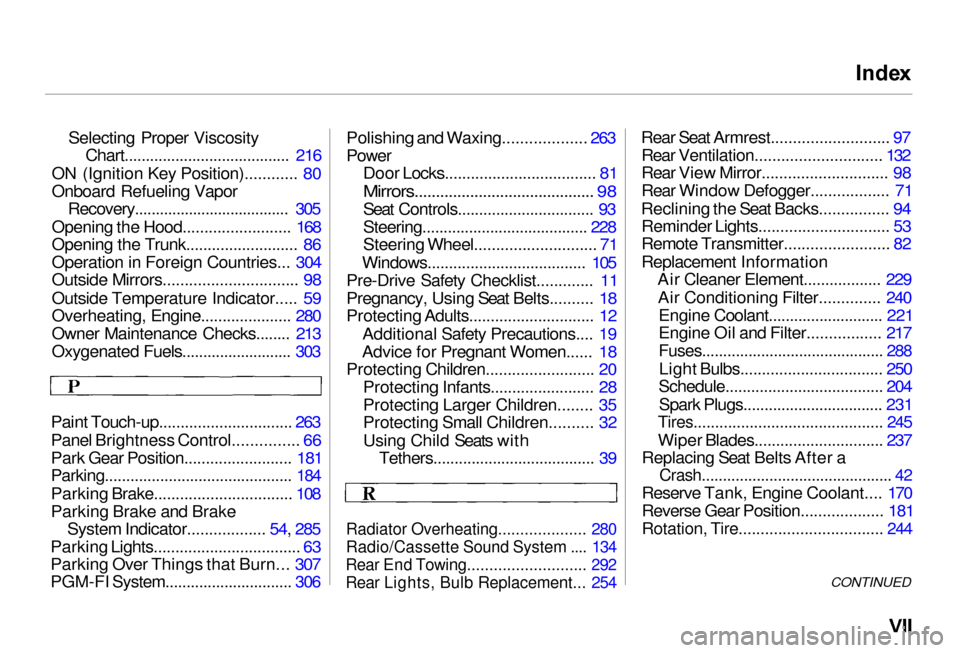
Inde
x
Selecting Proper Viscosity Chart....................................... 216
ON (Ignition Key Position)............ 80
Onboard Refueling Vapor Recovery..................................... 305
Opening the Hood......................... 168
Opening the Trunk.......................... 86
Operation in Foreign Countries... 304
Outside Mirrors............................... 98
Outside Temperature Indicator..... 59
Overheating, Engine..................... 280
Owner Maintenance Checks........ 213
Oxygenated Fuels.......................... 303
Paint Touch-up............................... 263
Panel Brightness Control............... 66
Park Gear Position......................... 181
Parking............................................ 184
Parking Brake................................ 108
Parking Brake and Brake System Indicator.................. 54, 285
Parking Lights.................................. 63
Parking Over Things that Burn... 307
PGM-FI System.............................. 306
Polishing and Waxing................... 263
Power
Door Locks................................... 81
Mirrors.......................................... 98
Seat Controls...............................
. 93
Steering....................................... 228
Steering Wheel............................ 71
Windows..................................... 105
Pre-Drive Safety Checklist............. 11
Pregnancy, Using Seat Belts.......... 18
Protecting Adults............................. 12
Additional Safety Precautions.... 19
Advice for Pregnant Women...... 18
Protecting Children......................... 20
Protecting Infants........................ 28
Protecting Larger Children........ 35
Protecting Small Children.......... 32
Using Child Seats withTethers...................................... 39
Radiator Overheating.................... 280
Radio/Cassette Sound System .... 134
Rear End Towing........................... 292
Rear Lights, Bulb Replacement... 254
Rear Seat Armrest........................... 97
Rear Ventilation............................. 132
Rear View Mirror............................. 98
Rear Window Defogger.................. 71
Reclining the Seat Backs................ 94
Reminder Lights.............................. 53
Remote Transmitter........................ 82
Replacement Information Air Cleaner Element.................. 229
Air Conditioning Filter.............. 240 Engine Coolant........................... 221
Engine Oil and Filter................. 217
Fuses........................................... 288
Light Bulbs................................. 250
Schedule..................................... 204
Spark Plugs................................. 231
Tires............................................ 24
5
Wiper Blades.............................. 237
Replacing Seat Belts After a
Crash............................................. 42
Reserve Tank, Engine Coolant.... 170
Reverse Gear Position................... 181
Rotation, Tire................................. 244
CONTINUED